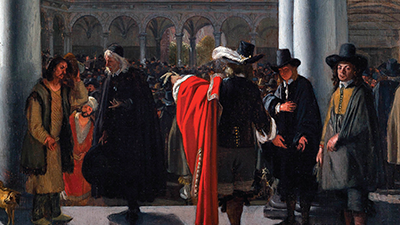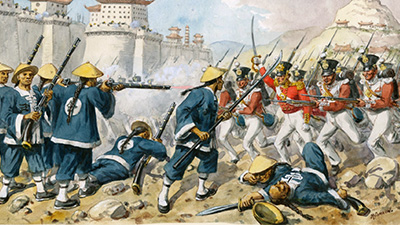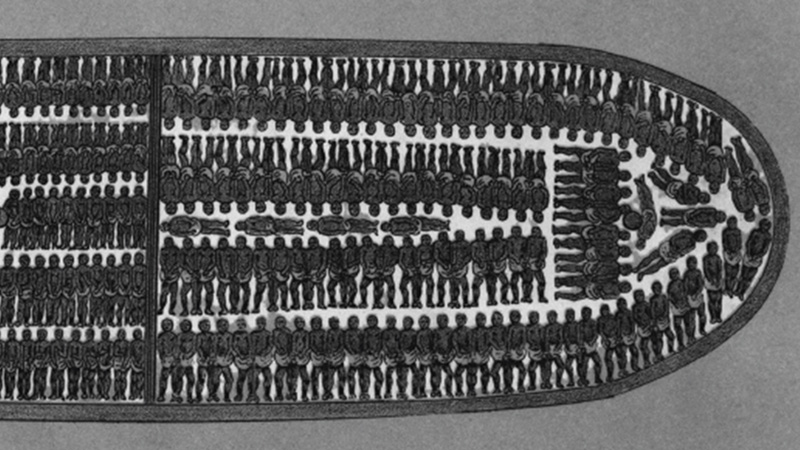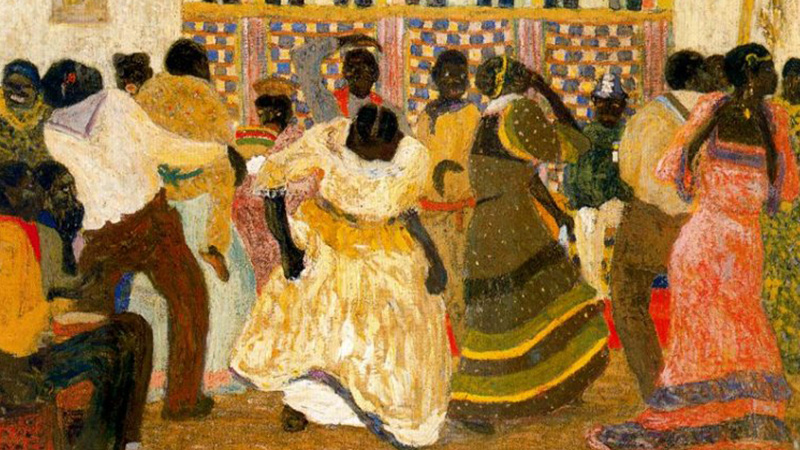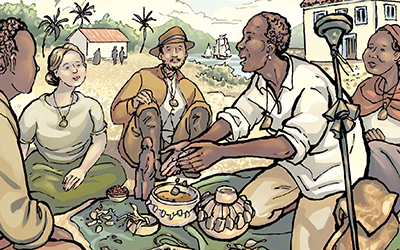Maritime Empires Maintained and Developed
Teacher Resources
Driving Question: How did rulers and merchants use new economic strategies to expand their power and increase their wealth from c. 1450 to 1750 CE?
The new global age born from maritime exploration also gave rise to new economic and labor systems. In this lesson, you will explore how maritime empires extracted and exploited resources and people from their colonies in order to grow and expand their power and influence from the fifteenth to eighteenth centuries.
Learning Objectives
- Explain how rulers employed economic strategies to consolidate and maintain power throughout the period from 1450 to 1750.
- Explain the continuities and changes in networks of exchange from 1450 to 1750.
- Explain how political, economic, and cultural factors affected societies from 1450 to 1750.
- Explain the similarities and differences in how various belief systems affected societies from 1450 to 1750.
- Evaluate the changes and continuities to economic and labor systems as new transoceanic empires expanded, and the strategies maritime empires used to maintain their power.
- Analyze primary source documents to understand how individuals experienced the transatlantic slave trade.
- Use graphic biographies as microhistories to support, extend, or challenge the overarching narratives from this region.
Vocab Terms:
- capitalism
- commodity
- indigenous
- joint-stock company
- mercantilism
- Transatlantic slave trade
Opener: Maritime Empires Maintained and Developed
To teach this lesson step, refer to page 3 of the Lesson 4.5 Teaching Guide.
To see where the AP themes show up throughout the course, you can reference the “Pieces” Themes Chart.
The six AP themes are like a map and compass: they help you navigate world history and avoid getting lost.
Overview of New Economic Systems
To teach this lesson step, refer to page 4 of the Lesson 4.5 Teaching Guide.
Credit cards are common today, but there was a time when the notion of credit was entirely new! What effect do you think this had on the economics of the time. What effect does the availability of credit have on us today?
-
Guiding Questions
-
Before you read
Preview the questions below, and then skim the article. Be sure to look at the section headings and any images.
While you read
Look for answers to these questions:
- In what ways was the European use of credit in this period a continuation of older practices? In what ways was it a change?
- What was the impact of Fibonacci’s book, according to the author?
- Why was a bill of exchange useful?
- What financial innovation did the British East India Company and Dutch East India Company rely on?
- What was the economic role of colonies for Europeans in this era?
After you read
Respond to the following questions:
- According to the article, explain how rulers employed economic strategies to consolidate and maintain power throughout the period from 1450 to 1750.
- Why do you think the changes in financial and economic practices in European trading companies matter to world history in this period?
The Spanish Empire, Silver, and Runaway Inflation: Crash Course World History #25
To teach this lesson step, refer to page 5 of the Lesson 4.5 Teaching Guide.
Is silver responsible for the life we have today? That’s what John Green claims in this Crash Course video. Let’s see if you think he’s right!
-
Guiding Questions
-
Before you watch
Preview the questions below, and then review the transcript.
While you watch
Look for answers to these questions:
- How was the Aztec government and society structured?
- How did the Inca Empire’s administration work, and what were the differences between how the Aztec and Inca treated conquered peoples?
- What resource did the Spanish find instead of gold, and how did they extract this resource?
- What were the economic results of Spanish silver mining in the Americas?
- What other country had a problem with inflation? How did they try to deal with it, and were they successful?
- What were some effects of China’s new tax structure in the sixteenth century?
- What were the overall global effects of Spanish silver mining?
After you watch
Respond to the following questions:
- What evidence does this video provide to explain the continuities and changes in economic and labor systems from 1450 to 1750?
- John Green argues that Spanish silver mining had a huge impact that was both global and long-lasting. He claims that “this process led to the life that you have today, one where I can teach you history through the magic of the Internet.” Is his argument convincing? What other sources or facts support, extend, or challenge his argument?
Key Ideas
The East India Company: Pioneering Corporation or Plundering Pirates?
To teach this lesson step, refer to page 7 of the Lesson 4.5 Teaching Guide.
How did powerful trading corporations like the East India Company shape the flow of goods, people, and capital across continents? A lot of it has to do with money.
-
Guiding Questions
-
Before you read
Preview the questions below, and then skim the article. Be sure to look at the section headings and any images.
While you read
Look for answers to these questions:
- What was the East India Company and when did it start operating?
- Why did the EIC get so powerful in India?
- What strategies did the company use to rule India?
- Why did the company begin to decline and collapse?
- What policies of the EIC helped spark the 1857 uprising?
After you read
Respond to these questions: What do you think is the legacy of the EIC? Was it a pioneering corporation? Or were they merely pirates and criminals?
Thematic Connections: Maritime Empires
How were the Americas, Africa, and Europe similar from c. 1450 to 1750 CE? The AP® themes can help you answer this question.
Source Collection: First Person Accounts of the Transatlantic Slave Trade
To teach this lesson step, refer to page 7 of the Lesson 4.5 Teaching Guide.
Looking for guiding questions to use with Quick Sourcing – First Person Accounts of the Transatlantic Slave Trade? Check out this thread in the Community Forum.
The Transatlantic Slave Trade is a challenging topic to read about. For guidance on navigating sensitive material, explore our OER Project Sensitive Topics in Social Studies Guide.
Primary source documents give us a sense of what life was like during a historic period. These documents show us the horrific and dangerous conditions African captives faced as they were transported against their will into slavery in the New World. Use the Quick-Sourcing Tool to help you analyze these primary source excerpts.
Impact of the Slave Trade: Through a Ghanaian Lens
To teach this lesson step, refer to page 7 of the Lesson 4.5 Teaching Guide.
The Atlantic slave trade radically impacted Africa; but was its impact the same throughout the continent? Looking through the Ghanaian lens can provide us with some insight.
-
Guiding Questions
-
Before you watch
Preview the questions below, and then review the transcript.
While you watch
Look for answers to these questions:
- How do Ato Ashun and Trevor Getz describe society around Cape Coast prior to the Atlantic slave trade?
- What does the physical structure of Cape Coast Castle under the British, including its dungeons, tell us about the Atlantic slave trade?
- What, according to Ato Ashun, were some of the economic impacts of the Atlantic slaving system on the coastal region?
- According to Akosua Perbi, how did the Atlantic slaving system affect how people lived?
- What impacts of the Atlantic slaving system does Wilhelmina Donkoh focus on in her interview?
- How does Ato Ashun say that the evidence of the Atlantic slave trade, in the dungeons of Cape Coast Castle, affected him personally?
After you watch
Respond to the following questions:
- What evidence does this video provide to explain changes and continuities in systems of slavery in the period from 1450 to 1750?
- How did the Atlantic slave trade affect Ghana, in terms of social interactions and organization as well as economic systems? Do you think these effects were the same in other regions of Africa? Why or why not?
- If you were a guide for tourists visiting Cape Coast Castle, what would you want to tell them about the site?
How did the Atlantic slave trade impact Africa? We can study a smaller region to try to determine bigger answers.
Key Ideas
Syncretic Beliefs
Syncretism has a long history that stretches back to antiquity, but syncretic beliefs connected people in new ways in the Americas from c. 1450 to 1750 CE.
-
Guiding Questions
-
Before you read
Preview the questions below, and then skim the article. Be sure to look at the section headings and any images.
While you read
Look for answers to these questions:
- Why didn’t Christian belief systems in the Americas undergo the same level of modification that Indigenous and African belief systems did?
- How was syncretism a form of cultural survival and resistance?
- What belief systems did the Yoruba priestess Francisca da Silva blend to create Candomblé?
- Describe two examples of syncretic beliefs developed in the Americas from c. 1450 to 1750 CE that combined African and European customs.
- How did Indigenous Americans develop syncretic belief systems from c. 1450 to 1750 CE?
After you read
Respond to these questions:
- How was the development of syncretic beliefs in the Americas from c. 1450 to 1750 CE different from syncretism in Afro-Eurasia from c. 1200 to 1450 CE?
- How did cultural developments and interactions affect social interactions and organization in maritime empires from c. 1450 to 1750?
Closer: Maritime Empires Maintained and Developed
To teach this lesson step, refer to page 9 of the Lesson 4.5 Teaching Guide.
Want to scaffold the process of reading a Graphic Biography? Use the Three Close Reads – Graphic Biographies Tool.
Domingos Álvares was one of more than twelve million Africans enslaved to labor in the Americas. But this did not define his identity. As historian James Sweet tells us, he was a healer who created a community and a network around him wherever he went.
-
Guiding Questions
-
Before you read
Preview the questions below, and then skim the comic, paying attention to things like prominent colors, shapes, and types of text and fonts. How do you know where to start and in which direction to read? What’s in the gutters (the space between panels)? Who or what is the focus of the comic?
While you read
Look for answers to these questions:
- When and where was Domingos Álvares born?
- What was Álvares’ occupation, and why did this lead to his capture and sale to European slavers by the King of Dahomey?
- Why was Álvares imprisoned in 1733?
- Why did the Catholic Church try to imprison Álvares in 1742?
- How does the artist demonstrate the importance of community to Álvares?
After you read
Respond to the following questions:
- Using evidence from this comic, explain how Álvares’ story supports, extends, or challenges what you’ve learned about social categories and practices in this era.
- How is Álvares’ biography evidence of the kinds of networks people built across regions, and the transfer of ideas from one region to another in this era? How does this evidence support, extend, or challenge your understanding of the impact of the Atlantic slave trade?


